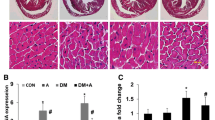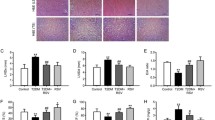Abstract
The present study was to determine the preventive effect of resveratrol (Res) on diabetes-induced cardiac dysfunction and the possible signaling pathway involved. Diabetes was induced in rats by injection of streptozotocin (STZ) at 45 mg/kg. The animals were randomly divided into three groups (10 rats/group): normal group, diabetes groups with or without Res (80 mg/kg) treatment. Biochemistry, cardiac function and fibrosis were detected. Moreover, pro-inflammatory cytokines were evaluated, and heart tissues were homogenized for western blot analysis to analyze the possible mechanisms. The results indicated that Res might regulate glucose and lipid metabolism, ameliorate cardiac function and fibrosis response in STZ-induced diabetic rats. The protective effects were consistent with the inhibition of inflammatory factors such as TNF-α, IL-6 and IL-1β. In addition, Res favorably shifted STZ-induced AT1R, ERK1/2 and p38 MAPK activation in rat heart. In conclusion, the results suggested that Res attenuated diabetes-induced cardiac dysfunction, and the effects were associated with attenuation inflammatory response and down-regulation of AT1R-ERK/p38 MAPK signaling pathway.





Similar content being viewed by others
References
Wild, S., Roglic, G., Green, A., Sicree, R., & King, H. (2004). Global prevalence of diabetes: Estimates for the year 2000 and projections for 2030. Diabetes Care, 27, 1047–1053.
Bell, D. S. (2003). Heart failure: The frequent, forgotten, and often fatal complication of diabetes. Diabetes Care, 26, 2433–2441.
Boudina, S., & Abel, E. D. (2007). Diabetic cardiomyopathy revisited. Circulation, 115, 3213–3223.
Chang, S. H., Liu, C. J., Kuo, C. H., Chen, H., Lin, W. Y., Teng, K. Y., et al. (2011). Garlic oil alleviates MAPKs- and IL-6-mediated diabetes-related cardiac hypertrophy in STZ-induced DM rats. Evidence-Based Complementary and Alternative Medicine, 2011, 950150.
Gava, E., Samad-Zadeh, A., Zimpelmann, J., Bahramifarid, N., Kitten, G. T., Santos, R. A., et al. (2009). Angiotensin-(1–7) activates a tyrosine phosphatase and inhibits glucose-induced signalling in proximal tubular cells. Nephrology, Dialysis, Transplantation, 24, 1766–1773.
Borriello, A., Cucciolla, V., Della Ragione, F., & Galletti, P. (2010). Dietary polyphenols: Focus on resveratrol, a promising agent in the prevention of cardiovascular diseases and control of glucose homeostasis. Nutrition, Metabolism and Cardiovascular Diseases, 20, 618–625.
Liu, K., Zhou, R., Wang, B., & Mi, M. T. (2014). Effect of resveratrol on glucose control and insulin sensitivity: A meta-analysis of 11 randomized controlled trials. American Journal of Clinical Nutrition, 99, 1510–1519.
Tomé-Carneiro, J., Gonzálvez, M., Larrosa, M., Yáñez-Gascón, M. J., García-Almagro, F. J., Ruiz-Ros, J. A., et al. (2012). One-year consumption of a grape nutraceutical containing resveratrol improves the inflammatory and fibrinolytic status of patients in primary prevention of cardiovascular disease. American Journal of Cardiology, 110, 356–363.
Olson, E. R., Naugle, J. E., Zhang, X., Bomser, J. A., & Meszaros, J. G. (2005). Inhibition of cardiac fibroblast proliferation and myofibroblast differentiation by resveratrol. American Journal of Physiology Heart and Circulatory Physiology, 288, H1131–H1138.
Bidasee, K. R., Zhang, Y., Shao, C. H., Wang, M., Patel, K. P., Dincer, U. D., & Besch, H. R, Jr. (2004). Diabetes increases formation of advanced glycation end products on Sarco(endo) plasmic reticulum Ca2+-ATPase. Diabetes, 53, 463–473.
Li, C., Gao, Y., Tian, J., Xing, Y., Zhu, H., & Shen, J. (2012). Long-term oral Asperosaponin VI attenuates cardiac dysfunction, myocardial fibrosis in a rat model of chronic myocardial infarction. Food and Chemical Toxicology, 50, 1432–1438.
Venkatachalam, K., Mummidi, S., Cortez, D. M., Prabhu, S. D., Valente, A. J., & Chandrasekar, B. (2008). Resveratrol inhibits high glucose-induced PI3K/Akt/ERK-dependent interleukin-17 expression in primary mouse cardiac fibroblasts. American Journal of Physiology Heart and Circulatory Physiology, 294(5), H2078–H2087.
Novaes, R. D., Peluzio, Mdo C., & Maldonado, I. R. (2012). Resveratrol causes antiatherogenic effects in an animal model of atherosclerosis. Arquivos Brasileiros de Cardiologia, 98(6), 571.
Göçmen, A. Y., Burgucu, D., Karadoğan, I., Timurağaoğlu, A., & Gümüşlü, S. (2013). The effect of trans-resveratrol on platelet-neutrophil complex formation and neutrophil burst in hypercholesterolemic rats. Experimental & Clinical Cardiology, 18(2), e111–e114.
Farb, M. G., Bigornia, S., Mott, M., Tanriverdi, K., Morin, K. M., Freedman, J. E., et al. (2011). Reduced adipose tissue inflammation represents an intermediate cardiometabolic phenotype in obesity. Journal of the American College of Cardiology, 58, 232–237.
Movahed, A., Nabipour, I., Lieben, L. X., Thandapilly, S. J., Yu, L., Kalantarhormozi, M., et al. (2013). Antihyperglycemic effects of short term resveratrol supplementation in type 2 diabetic patients. Evidence-Based Complementary and Alternative Medicine, 2013, 851267.
Adeghate, E., Kalasz, H., Veress, G., & Teke, K. (2010). Medicinal chemistry of drugs used in diabetic cardiomyopathy. Current Medicinal Chemistry, 17, 517–551.
Luo, B., Li, B., Wang, W., Liu, X., Xia, Y., Zhang, C., et al. (2014). An FNLRP3 gene silencing ameliorates diabetic cardiomyopathy in a type 2 diabetes rat model. PLoS One, 9(8), e104771.
Cong, X., Li, Y., Lu, N., Dai, Y., Zhang, H., Zhao, X., & Liu, Y. (2014). Resveratrol attenuates the inflammatory reaction induced by ischemia/reperfusion in the rat heart. Molecular Medicine Reports, 9, 2528–2532.
Thomas, C. M., Yong, Q. C., Seqqat, R., Chandel, N., Feldman, D. L., Baker, K. M., & Kumar, R. (2013). Direct renin inhibition prevents cardiac dysfunction in a diabetic mouse model: Comparison with an angiotensin receptor antagonist and angiotensin-converting enzyme inhibitor. Clinical Science (Lond), 124, 529–541.
Yong, Q. C., Thomas, C. M., Seqqat, R., Chandel, N., Baker, K. M., & Kumar, R. (2013). Angiotensin type 1a receptor-deficient mice develop diabetes-induced cardiac dysfunction, which is prevented by renin-angiotensin system inhibitors. Cardiovascular Diabetol, 12, 169.
Rosenkranz, S. (2004). TGF-beta1 and angiotensin networking in cardiac remodeling. Cardiovascular Research, 63, 423–432.
Sugden, P. H., & Clerk, A. (1998). Stress-responsive mitogen-activated protein kinases (c-Jun N-terminal kinases and p38 mitogen-activated protein kinases) in the myocardium. Circulation Research, 83, 345–352.
Tibbles, L. A., & Woodgett, J. R. (1999). The stress-activated protein kinase pathways. Cellular and Molecular Life Sciences, 55, 1230–1254.
Lakshmanan, A. P., Harima, M., Sukumaran, V., Soetikno, V., Thandavarayan, R. A., Suzuki, K., et al. (2012). Modulation of AT-1R/AMPK-MAPK cascade plays crucial role for the pathogenesis of diabetic cardiomyopathy in transgenic type 2 diabetic (Spontaneous Diabetic Torii) rats. Biochemical Pharmacology, 83, 653–660.
Erdogan, D., Yucel, H., Uysal, B. A., Ersoy, I. H., Icli, A., Akcay, S., et al. (2013). Effects of prediabetes and diabetes on left ventricular and coronary microvascular functions. Metabolism, 62, 1123–1130.
Li, J., Peng, L., Du, H., Wang, Y., Lu, B., Xu, Y., et al. (2014). The protective effect of beraprost sodium on diabetic cardiomyopathy through the inhibition of the p38 MAPK signaling pathway in high-fat-induced SD rats. International Journal of Endocrinology, 2014, 901437.
Xu, H., Xiong, C., He, L., Wu, B., Peng, L., Cheng, Y., et al. (2013). Trans- resveratrol attenuates high fatty acid-induced P2X7 receptor expression and IL-6 release in PC12 cells: Possible role of P38 MAPK pathway. Inflammation, 94, 63–70.
Miyazaki, R., Ichiki, T., Hashimoto, T., Inanaga, K., Imayama, I., Sadoshima, J., & Sunagawa, K. (2008). SIRT1, a longevity gene, downregulates angiotensin II type 1 receptor expression in vascular smooth muscle cells. Arteriosclerosis, Thrombosis, and Vascular Biology, 28, 1263–1269.
Biala, A., Tauriainen, E., Siltanen, A., Shi, J., Merasto, S., Louhelainen, M., et al. (2010). Resveratrol induces mitochondrial biogenesis and ameliorates Ang II-induced cardiac remodeling in transgenic rats harboring human renin and angiotensinogen genes. Blood Pressure, 19, 196–205.
Chen, T., Li, J., Liu, J., Li, N., Wang, S., Liu, H., et al. (2014). Activation of SIRT3 by resveratrol ameliorates cardiac fibrosis and improves cardiac function via TGF-β/Smad3 pathway. American Journal of Physiology Heart and Circulatory Physiology. doi:10.1152/ajpheart.00454.2014.
Acknowledgments
This work was supported by the Natural Science Foundation of Shandong Province (No. ZR2014JL048) and National Natural Science Foundation of China (No. 20973149).
Conflict of interest
None.
Author information
Authors and Affiliations
Corresponding authors
Rights and permissions
About this article
Cite this article
Gao, Y., Kang, L., Li, C. et al. Resveratrol Ameliorates Diabetes-Induced Cardiac Dysfunction Through AT1R-ERK/p38 MAPK Signaling Pathway. Cardiovasc Toxicol 16, 130–137 (2016). https://doi.org/10.1007/s12012-015-9321-3
Published:
Issue Date:
DOI: https://doi.org/10.1007/s12012-015-9321-3




